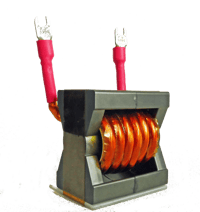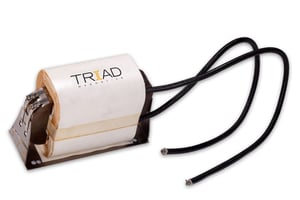In our most recent blog, we introduced Litz wire and discussed its various uses and properties. Litz wire is a multi-strand wire used to conduct alternating current (AC) at radio frequencies. Individually insulated magnet wires are braided together in a pattern that helps reduce AC losses from skin effects and proximity effects found in high-frequency windings.
In this blog, we’ll compare Litz wire and copper foil—a thin metal sheet made from soft copper—and discuss their applications in transformer design.
Litz Wire Advantages
Perhaps the biggest advantage that Litz wire can offer over any alternative is the reduction of AC losses due to skin effect.
Skin effect refers to an increase in a conductor's electrical resistance due to current migration towards the outer surface of the wire or cable. It is often observed in high-frequency (10khz to 1 mhz) windings that contain smaller skin depth. Litz wire allows the flow of the alternating current to be cleanly divided between multiple braided strands. As a result, magnetic devices that utilize Litz wire enjoy operational efficiency 50-100% higher than devices using traditional magnet wire.
Other advantages of Litz wire include:
- Litz wire offers significantly improved packing density. It can be packed into smaller physical spaces than traditional magnet wire, providing a noteworthy benefit for designers.
- Engineers frequently form Litz wire into square, keystone, or rectangular shapes, allowing them to optimize the quality of circuits while minimizing AC resistance.
- Litz wire also reduces current losses from the proximity effect—the disruption of current flow from nearby magnetic fields.
Litz wire is useful in a broad spectrum of applications, such as:
- Ballast
- Chokes
- DC to DC converters
- Flywheel energy storage
- High frequency power supplies
- High Q circuits
- Induction heating coils
- Inductors
- Inverters
- Low impedance grounding
- Motors
- Permanent magnet motors
- Plasma containment coils
- Specialty auto
- Transformers and toroidal transformers
Copper Foil Inductors
Copper foil inductors also offer several practical benefits for engineers and manufacturers. These include the following advantages:
- Size reduction. Windings made from copper foil optimize space.
- Temperature control. Copper foil dissipates heat more effectively than magnet wire.
- Reduced voltage stress. Copper foil facilitates a reduction in voltage stresses between the turns in the winding.
- More robust. Foil-wound components offer increased mechanical strength compared to wire-wound components
- Cost effective. Copper foil is much more affordable than Litz wire.
Partnering with Triad Magnetics
Litz wire and copper foil each offer unique benefits suitable for specific purposes. We hope the information presented here will assist you in determining the best choice for your application.
At Triad Magnetics, our team of expert engineers can assist you with the selection process, ensuring that you get the right materials for your design. We have extensive experience with both Litz wire and copper foil, so we know when each type of wire is appropriate. We can use Litz wire and copper foil to create a wide range of custom product solutions.
If you'd like to learn more about Litz wire and copper foil, please contact us or request a quote. We look forward to working with you on your next design challenge.






